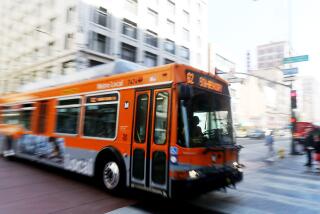Metrolink adds video cameras to locomotives
- Share via
Metrolink engineers are now being recorded by video cameras in all of the commuter rail agency’s locomotives. Installation of the cameras comes in response to the deadly 2008 rail crash in Chatsworth that apparently involved a distracted engineer.
“Metrolink becomes the first rail system in the entire nation, passenger or freight, to install and operate these cameras,” Metrolink Board Chairman Keith Millhouse said at a morning news conference Monday at the agency’s maintenance facility near Elysian Park.
The purpose of the recorders is to ensure that engineers comply with bans on cellphones, text messaging and unauthorized passengers -- issues that arose during the federal investigation of the Chatsworth crash. Two cameras face the engineer and a third is pointed toward the tracks. The recordings are kept in “crash-worthy” metal boxes inside the locomotive, Metrolink officials said.
It cost $1 million to install cameras in all 52 of Metrolink’s locomotives.
They will also be standard equipment in 57 new “lead cars” -- passengers cars that lead commuter trains when the locomotive is pushing from behind.
Los Angeles Mayor Antonio Villaraigosa said the cameras have already proved successful on buses and light-rail lines operated by the Los Angeles County Metropolitan Transportation Authority.
“The inward-facing camera will be our eyes and ears to improve passenger safety and ensure the highest standards of professionalism by train operators,” Villaraigosa said.
Metrolink officials will download the recordings after any reported incident, and randomly review the tapes to spot violations.
The recorders store 96 hours of images, but new data will be recorded over the information if it is not downloaded.
The Brotherhood of Locomotive Engineers and Trainmen, the union representing the Metrolink engineers, has called the cameras ineffective, and an invasion of privacy.
The union plans to take legal action to remove them.
“If guys fall asleep or go through a red signal, whether the camera is there or not doesn’t really make a difference. The camera doesn’t have a magic button to stop the train,” said Timothy Smith, chairman of the union’s California legislative board.
Instead, Metrolink should staff each locomotive with two engineers and install positive train-control systems, he said. Those high-tech braking systems use digital communications with Global Positioning System technology to monitor train locations and speeds, and if engineers fail to comply with signals, the train automatically applies the brakes.
Metrolink board member Richard Katz said the agency plans to install the on-board automatic braking systems on all its trains by 2012.
The head-on collision between Metrolink 111 and a Union Pacific freight train on Sept. 12, 2008, in Chatsworth was the worst rail disaster in modern California history, killing 25 people and injuring 135.
Federal investigators determined that a Metrolink engineer working for Connex Railroad was text messaging on a cellphone -- a violation of rules -- at the time of the crash and apparently ran a red light.
The engineer, Robert M. Sanchez, had a history of text-messaging while on duty and had been warned about cellphone use on locomotives.
--
More to Read
Sign up for Essential California
The most important California stories and recommendations in your inbox every morning.
You may occasionally receive promotional content from the Los Angeles Times.














